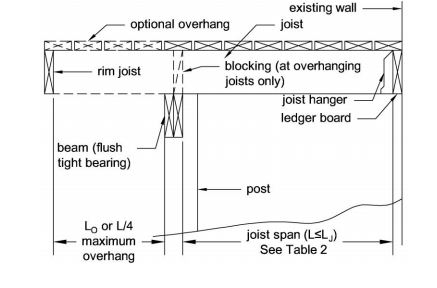Q: In the first section of the deck portion of Chapter 5 in the 2009 to 2015 versions of the IRC, it says: “For decks with cantilevered framing members, connection to exterior walls or other framing members shall be designed and constructed to resist uplift resulting from the full live load specified in Table R301.5 acting on the cantilevered portion of the deck” (R507.1 2015 IRC). If the live load is 40 PSF (the listing for decks in Table R301.5), will joist hangers mounted to the ledger provide adequate uplift resistance? Is there any circumstance where a deck builder would need to use special hardware to account for uplift?
A: Andrew Wormer, PDB editor, responds: There are a couple of ways to approach this question. If you’re following the prescriptive path spelled out in the IRC or in the American Wood Council’s DCA-6 (The Prescriptive Residential Deck Construction Guide), you don’t have to worry: Joist hangers have plenty of built-in capacity for the uplift forces created by a live load on a properly-framed deck. Use the span tables in either IRC or DCA-6 to size the joists and cantilevers, install blocking and connectors or fasteners (ie. Hurricane clips or toe nails) at the joist-to-beam location as required, and attach the joists to the ledger with approved joist hangers and you’ve met the uplift requirement in R507.1.
You could veer off the prescriptive path, of course, in which case you’ll want to consult an engineer. That’s what I did when I contacted David Finkenbinder, who is an engineer at Simpson Strong-Tie, for his thoughts about the question. When I asked him how one might go about calculating uplift, he responded by sending me some indecipherable (at least by me) engineering equations, but also promised to do some math based on the longest possible joist and cantilever spans and with the live load only present on the joist cantilever. Even with 2×12 SYP joists 24-in. o.c. spanning 13-ft. 6-in. with an additional 3-ft. 4-in. cantilever, he found the maximum resulting uplift to be less than 40 pounds. This is well within the uplift capacity listed for common joist hangers.
You can easily find uplift values for Simpson Strong-Tie and USP hangers in their published technical literature. For reference, Simpson’s LUS210Z double-shear joist hanger provides for 1,165 pounds of uplift, which is plenty even after the required wet service reduction has been factored in. Standard joist hangers such as SST’s LU210 (850-lbs.) or USP’s JL28 (855-lbs.) also have plenty of uplift capacity.
According to Finkenbinder, the main reason why the uplift calculations find such a small reaction is due to the IRC limiting the cantilever span to ¼ of the adjacent joist span. But he warns that if you are designing a deck outside of the IRC limits where this ratio starts to exceed ¼, the amount of uplift generated increases substantially. As the back span decreases in length, it may become possible that joist hangers alone are not sufficient and additional reinforcement may be required. Live loads that are significantly larger than the standard 40 psf (per the IRC) can also generate more uplift.
Finkenbinder also notes that the deck provisions in the IRC are still a work in progress, and are nowhere near as comprehensive or complex as other sections of the code (such as Chapter 6-Wall Construction and Chapter 8-Roof-Ceiling Construction). For example, for decks, the IRC doesn’t take into account high winds or other special loading conditions.
